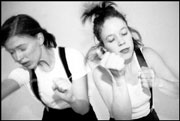D9 DANCE COLLECTIVE
Velocity MainSpace Theater, 915 E. Pine, second floor, 781-7746, $12-$14 8 p.m. Fri., June 8-Sat., June 10
SHOOTING FROM the hip is an immediate response, not anticipated or planned. d9 Dance Collective’s new concert, from the hip, has that sense of immediacy, but some of the shots are right on target, while a few fall short of the mark.
In “Compass,” Mary Sheldon Scott works again with composer Jarrad Powell, whose score of bubbly static adds a sense of agitation to the atmosphere. In the opening section, six women alternate between small adjustments and urgent running patterns, changing places with each other only to return to their small, internal dance. Eventually they’re joined by a seventh woman (Michele Miller) who does a solo full of whipping energy and extended, twisted poses, while the others remain as silent witnesses. It seemed as if Scott might create a shared vocabulary out of all these parts, but the piece ends without that kind of resolution. As separate dances, the two sections could be quite satisfying, but as parts of a whole, they didn’t have the same organic quality.
33 Fainting Spells’ “O’er you watch do keep” left me with that same feeling of wanting more, but in this case the explanation is more straightforward—the piece was a study for their evening-length work Sorrow’s Sister. This duet alternates between moments of frustration and caring, as one partner squirms on a rickety bed while the other spasms and pounds on a table. Their relationship seems to be a longstanding one; the caretaker tends to her bedridden partner with both tenderness and rote repetition. She is brusque and kind, and as her patient convulses and twitches we feel that this is just a brief view into a harsh eternity, like a danced version of a Beckett play. Both Amie Baca and Diana Cardiff made their characters human without judging them.
IN NEW YORK-BASED choreographer Donna Uchizono’s “The Wayne Brothers,” Sara Jinks and Kate Kershbaum lurch and jerk through the space almost like cartoon characters. Their awkwardness is like an old vaudeville routine—when they’re not checking each other out, they’re positioning themselves in relationship to each other. The work finishes with them jittering along on widespread legs, arms open and chests expanded, like parade floats trying to catch an updraft.
The program ends with Michael Foley’s “Devotion,” another work that seems split in two. In the opening section, he develops a beautiful hand language, like an architectural version of American Sign, performed in silence with great clarity by Diana Cardiff, Theodora Fogarty, Michele Miller, and Freya Wormus. At this point, the emotion of the title is reflected in their deference to each other, their grace in taking turns. The piece changes with the addition of a score of traditional Balkan folk music, and their devotion becomes more physical, seen in long partnering sequences. The complexity of the earlier hand language gets subsumed in the lush weight-sharing, only coming to the surface in occasional cherishing gestures.
The women of d9 Dance Collective search for work that excites them, dances that “we all fight to do.” In from the hip, they’ve given themselves a set of works that showcase their skills and leave us looking forward to the next volley.








